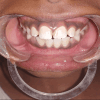Anterior Open Bite Treated With Palatal Crib and Myofunctional Therapy: A Case Report
- PMID: 39086779
- PMCID: PMC11290386
- DOI: 10.7759/cureus.63549
Anterior Open Bite Treated With Palatal Crib and Myofunctional Therapy: A Case Report
Abstract
The most prevalent oral habit and one of the most often habitual behavioral patterns in preschool-aged children is thumb-sucking. This behavior is crucial to the development of malocclusion and must be addressed carefully since it may cause a secondary tongue thrust that worsens the issue. Developing an effective treatment plan requires determining the underlying cause, which may include psychological, physiological, and or anatomical factors. Overall prevention of behavior needs to be planned for successful outcomes. One such device for treating tongue-thrusting and thumb-sucking habits is the palatal crib. The present case shows the possible effectiveness of palatal crib use in conjunction with myofunctional therapy for a child whose diagnosis involves habitually holding the tongue low and sucking the thumb that causes an anterior open bite (AOB). An 11-year-old boy with flared and spaced upper and lower incisors also had an AOB. Myofunctional therapy was combined with palatal cribs to help the tongue reposition itself and discourage the habit of sucking. The AOB was successfully corrected with an appropriate overjet and overbite after a total of three months of treatment.
Keywords: anterior open bite; myofunctional treatment; overbite; palatal crib; thumb sucking habit; tongue thrusting habit.
Copyright © 2024, Chandel et al.
Conflict of interest statement
Human subjects: All authors have confirmed that this study did not involve human participants or tissue. Conflicts of interest: In compliance with the ICMJE uniform disclosure form, all authors declare the following: Payment/services info: All authors have declared that no financial support was received from any organization for the submitted work. Financial relationships: All authors have declared that they have no financial relationships at present or within the previous three years with any organizations that might have an interest in the submitted work. Other relationships: All authors have declared that there are no other relationships or activities that could appear to have influenced the submitted work.
Figures




References
-
- Modified palatal crib appliance for habit correction: a case report. Shwetha G, Ashmitha Ks, Usha R, Pushpalatha C. https://www.researchgate.net/publication/336973177_Modified_Palatal_Crib... J Dent Orofac Res. 2017;13:61.
-
- Treating the tongue thrusting: a case report. Aggarwal N, Bansal K, Bansal BP. Am J Orthod Dentofacial Orthop. 2020;6:181–183.
-
- Anterior open bite treated with myofunctional therapy and palatal crib. Asiry MA. https://pubmed.ncbi.nlm.nih.gov/26057926/ J Contemp Dent Pract. 2015;16:243–247. - PubMed
Publication types
LinkOut - more resources
Full Text Sources
